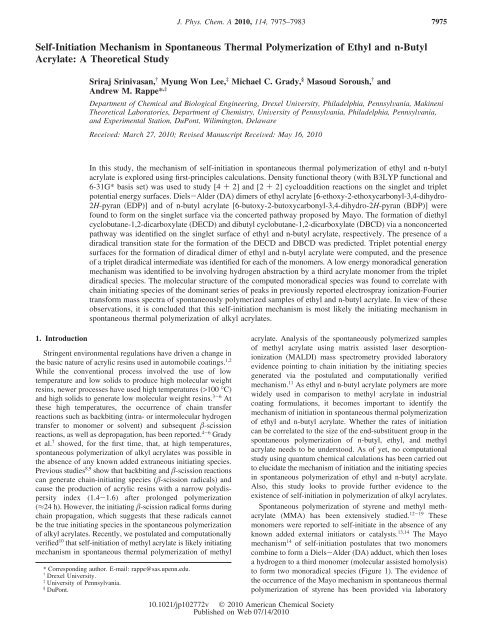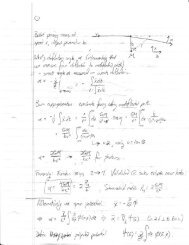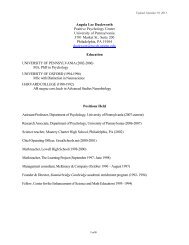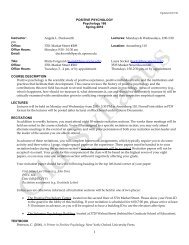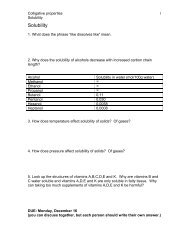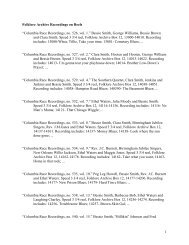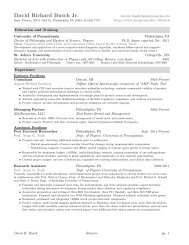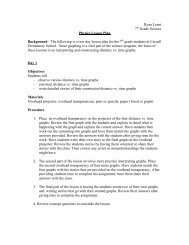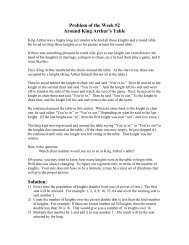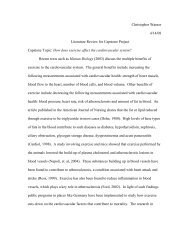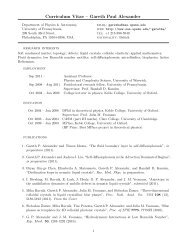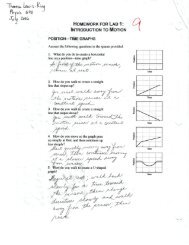Self-Initiation Mechanism in Spontaneous Thermal Polymerization of ...
Self-Initiation Mechanism in Spontaneous Thermal Polymerization of ...
Self-Initiation Mechanism in Spontaneous Thermal Polymerization of ...
Create successful ePaper yourself
Turn your PDF publications into a flip-book with our unique Google optimized e-Paper software.
J. Phys. Chem. A 2010, 114, 7975–7983 7975<br />
<strong>Self</strong>-<strong>Initiation</strong> <strong>Mechanism</strong> <strong>in</strong> <strong>Spontaneous</strong> <strong>Thermal</strong> <strong>Polymerization</strong> <strong>of</strong> Ethyl and n-Butyl<br />
Acrylate: A Theoretical Study<br />
Sriraj Sr<strong>in</strong>ivasan, † Myung Won Lee, ‡ Michael C. Grady, § Masoud Soroush, † and<br />
Andrew M. Rappe* ,‡<br />
Department <strong>of</strong> Chemical and Biological Eng<strong>in</strong>eer<strong>in</strong>g, Drexel UniVersity, Philadelphia, PennsylVania, Mak<strong>in</strong>eni<br />
Theoretical Laboratories, Department <strong>of</strong> Chemistry, UniVersity <strong>of</strong> PennsylVania, Philadelphia, PennsylVania,<br />
and Experimental Station, DuPont, Wilim<strong>in</strong>gton, Delaware<br />
ReceiVed: March 27, 2010; ReVised Manuscript ReceiVed: May 16, 2010<br />
In this study, the mechanism <strong>of</strong> self-<strong>in</strong>itiation <strong>in</strong> spontaneous thermal polymerization <strong>of</strong> ethyl and n-butyl<br />
acrylate is explored us<strong>in</strong>g first-pr<strong>in</strong>ciples calculations. Density functional theory (with B3LYP functional and<br />
6-31G* basis set) was used to study [4 + 2] and [2 + 2] cycloaddition reactions on the s<strong>in</strong>glet and triplet<br />
potential energy surfaces. Diels-Alder (DA) dimers <strong>of</strong> ethyl acrylate [6-ethoxy-2-ethoxycarbonyl-3,4-dihydro-<br />
2H-pyran (EDP)] and <strong>of</strong> n-butyl acrylate [6-butoxy-2-butoxycarbonyl-3,4-dihydro-2H-pyran (BDP)] were<br />
found to form on the s<strong>in</strong>glet surface via the concerted pathway proposed by Mayo. The formation <strong>of</strong> diethyl<br />
cyclobutane-1,2-dicarboxylate (DECD) and dibutyl cyclobutane-1,2-dicarboxylate (DBCD) via a nonconcerted<br />
pathway was identified on the s<strong>in</strong>glet surface <strong>of</strong> ethyl and n-butyl acrylate, respectively. The presence <strong>of</strong> a<br />
diradical transition state for the formation <strong>of</strong> the DECD and DBCD was predicted. Triplet potential energy<br />
surfaces for the formation <strong>of</strong> diradical dimer <strong>of</strong> ethyl and n-butyl acrylate were computed, and the presence<br />
<strong>of</strong> a triplet diradical <strong>in</strong>termediate was identified for each <strong>of</strong> the monomers. A low energy monoradical generation<br />
mechanism was identified to be <strong>in</strong>volv<strong>in</strong>g hydrogen abstraction by a third acrylate monomer from the triplet<br />
diradical species. The molecular structure <strong>of</strong> the computed monoradical species was found to correlate with<br />
cha<strong>in</strong> <strong>in</strong>itiat<strong>in</strong>g species <strong>of</strong> the dom<strong>in</strong>ant series <strong>of</strong> peaks <strong>in</strong> previously reported electrospray ionization-Fourier<br />
transform mass spectra <strong>of</strong> spontaneously polymerized samples <strong>of</strong> ethyl and n-butyl acrylate. In view <strong>of</strong> these<br />
observations, it is concluded that this self-<strong>in</strong>itiation mechanism is most likely the <strong>in</strong>itiat<strong>in</strong>g mechanism <strong>in</strong><br />
spontaneous thermal polymerization <strong>of</strong> alkyl acrylates.<br />
1. Introduction<br />
Str<strong>in</strong>gent environmental regulations have driven a change <strong>in</strong><br />
the basic nature <strong>of</strong> acrylic res<strong>in</strong>s used <strong>in</strong> automobile coat<strong>in</strong>gs. 1,2<br />
While the conventional process <strong>in</strong>volved the use <strong>of</strong> low<br />
temperature and low solids to produce high molecular weight<br />
res<strong>in</strong>s, newer processes have used high temperatures (>100 °C)<br />
and high solids to generate low molecular weight res<strong>in</strong>s. 3-6 At<br />
these high temperatures, the occurrence <strong>of</strong> cha<strong>in</strong> transfer<br />
reactions such as backbit<strong>in</strong>g (<strong>in</strong>tra- or <strong>in</strong>termolecular hydrogen<br />
transfer to monomer or solvent) and subsequent β-scission<br />
reactions, as well as depropagation, has been reported. 4-6 Grady<br />
et al. 7 showed, for the first time, that, at high temperatures,<br />
spontaneous polymerization <strong>of</strong> alkyl acrylates was possible <strong>in</strong><br />
the absence <strong>of</strong> any known added extraneous <strong>in</strong>itiat<strong>in</strong>g species.<br />
Previous studies 8,9 show that backbit<strong>in</strong>g and β-scission reactions<br />
can generate cha<strong>in</strong>-<strong>in</strong>itiat<strong>in</strong>g species (β-scission radicals) and<br />
cause the production <strong>of</strong> acrylic res<strong>in</strong>s with a narrow polydispersity<br />
<strong>in</strong>dex (1.4-1.6) after prolonged polymerization<br />
(≈24 h). However, the <strong>in</strong>itiat<strong>in</strong>g β-scission radical forms dur<strong>in</strong>g<br />
cha<strong>in</strong> propagation, which suggests that these radicals cannot<br />
be the true <strong>in</strong>itiat<strong>in</strong>g species <strong>in</strong> the spontaneous polymerization<br />
<strong>of</strong> alkyl acrylates. Recently, we postulated and computationally<br />
verified 10 that self-<strong>in</strong>itiation <strong>of</strong> methyl acrylate is likely <strong>in</strong>itiat<strong>in</strong>g<br />
mechanism <strong>in</strong> spontaneous thermal polymerization <strong>of</strong> methyl<br />
* Correspond<strong>in</strong>g author. E-mail: rappe@sas.upenn.edu.<br />
† Drexel University.<br />
‡ University <strong>of</strong> Pennsylvania.<br />
§ DuPont.<br />
acrylate. Analysis <strong>of</strong> the spontaneously polymerized samples<br />
<strong>of</strong> methyl acrylate us<strong>in</strong>g matrix assisted laser desorptionionization<br />
(MALDI) mass spectrometry provided laboratory<br />
evidence po<strong>in</strong>t<strong>in</strong>g to cha<strong>in</strong> <strong>in</strong>itiation by the <strong>in</strong>itiat<strong>in</strong>g species<br />
generated via the postulated and computationally verified<br />
mechanism. 11 As ethyl and n-butyl acrylate polymers are more<br />
widely used <strong>in</strong> comparison to methyl acrylate <strong>in</strong> <strong>in</strong>dustrial<br />
coat<strong>in</strong>g formulations, it becomes important to identify the<br />
mechanism <strong>of</strong> <strong>in</strong>itiation <strong>in</strong> spontaneous thermal polymerization<br />
<strong>of</strong> ethyl and n-butyl acrylate. Whether the rates <strong>of</strong> <strong>in</strong>itiation<br />
can be correlated to the size <strong>of</strong> the end-substituent group <strong>in</strong> the<br />
spontaneous polymerization <strong>of</strong> n-butyl, ethyl, and methyl<br />
acrylate needs to be understood. As <strong>of</strong> yet, no computational<br />
study us<strong>in</strong>g quantum chemical calculations has been carried out<br />
to elucidate the mechanism <strong>of</strong> <strong>in</strong>itiation and the <strong>in</strong>itiat<strong>in</strong>g species<br />
<strong>in</strong> spontaneous polymerization <strong>of</strong> ethyl and n-butyl acrylate.<br />
Also, this study looks to provide further evidence to the<br />
existence <strong>of</strong> self-<strong>in</strong>itiation <strong>in</strong> polymerization <strong>of</strong> alkyl acrylates.<br />
<strong>Spontaneous</strong> polymerization <strong>of</strong> styrene and methyl methacrylate<br />
(MMA) has been extensively studied. 12-19 These<br />
monomers were reported to self-<strong>in</strong>itiate <strong>in</strong> the absence <strong>of</strong> any<br />
known added external <strong>in</strong>itiators or catalysts. 13,14 The Mayo<br />
mechanism 14 <strong>of</strong> self-<strong>in</strong>itiation postulates that two monomers<br />
comb<strong>in</strong>e to form a Diels-Alder (DA) adduct, which then loses<br />
a hydrogen to a third monomer (molecular assisted homolysis)<br />
to form two monoradical species (Figure 1). The evidence <strong>of</strong><br />
the occurrence <strong>of</strong> the Mayo mechanism <strong>in</strong> spontaneous thermal<br />
polymerization <strong>of</strong> styrene has been provided via laboratory<br />
10.1021/jp102772v © 2010 American Chemical Society<br />
Published on Web 07/14/2010
7976 J. Phys. Chem. A, Vol. 114, No. 30, 2010 Sr<strong>in</strong>ivasan et al.<br />
Figure 1. Flory and Mayo mechanisms <strong>of</strong> self-<strong>in</strong>itiation for ethyl acrylate and n-butyl acrylate.<br />
experiments, 15-18 and theoretical studies us<strong>in</strong>g density functional<br />
calculations. 20 By contrast, Flory’s mechanism 13 <strong>of</strong> self-<strong>in</strong>itiation<br />
proposes two monomers to comb<strong>in</strong>e and form a diradical, which<br />
either undergoes r<strong>in</strong>g closure to form a cyclobutane derivative<br />
(reversible reaction) or undergoes hydrogen transfer or abstraction<br />
with a third monomer to form monoradical species.<br />
However, whether the diradical <strong>in</strong> its ground (s<strong>in</strong>glet) state can<br />
undergo hydrogen transfer or abstraction reactions is questionable.<br />
Pryor and Laswell 18 postulated that the diradical species,<br />
probably <strong>in</strong> a triplet (excited) state, is the one that generates<br />
monoradical species for <strong>in</strong>itiat<strong>in</strong>g polymerization <strong>in</strong> nonstyrenic<br />
monomers. The absence <strong>of</strong> Diels-Alder adducts and the<br />
<strong>in</strong>volvement <strong>of</strong> diradical species <strong>in</strong> <strong>in</strong>itiation <strong>of</strong> spontaneous<br />
thermal polymerization <strong>of</strong> MMA, which supports the postulate<br />
<strong>of</strong> Pryor and Lasswell, 18 have been reported. 19 Our recent<br />
computational study shows the <strong>in</strong>ability <strong>of</strong> the Diels-Alder<br />
adducts to form monoradical species, and the necessity <strong>of</strong> a<br />
triplet diradical <strong>in</strong>termediate to generate <strong>in</strong>itiat<strong>in</strong>g species for<br />
spontaneous thermal polymerization <strong>of</strong> methyl acrylate. 10<br />
Salem and Rowland 21 and others 22-27 have reported the<br />
occurrence <strong>of</strong> diradical crossover from s<strong>in</strong>glet to triplet state,<br />
the rules for such crossover, and the possible mechanisms for<br />
such <strong>in</strong>tersystem cross<strong>in</strong>g. The sp<strong>in</strong>-orbit coupl<strong>in</strong>g mechanism 21<br />
for <strong>in</strong>tersystem cross<strong>in</strong>g from diradical s<strong>in</strong>glet to triplet state<br />
has been shown to occur <strong>in</strong> various species, <strong>in</strong> particular, those<br />
similar <strong>in</strong> size and structure to ethyl and n-butyl acrylate. An<br />
important requirement to facilitate crossover is the existence<br />
<strong>of</strong> a dense manifold <strong>of</strong> vibrational states <strong>in</strong> the s<strong>in</strong>glet-triplet<br />
system. 22 This <strong>in</strong>creases the probability for overlap <strong>of</strong> s<strong>in</strong>glet<br />
and triplet vibrational states and subsequent <strong>in</strong>tersystem cross<strong>in</strong>g.<br />
Previous studies <strong>in</strong>dicate that collision between diradicals and<br />
<strong>in</strong>ert solvent, monomer or gas molecules at high temperatures<br />
can <strong>in</strong>crease the rate <strong>of</strong> crossover. 23-25<br />
Previous computational studies show that the transition state<br />
geometries and energy barriers calculated <strong>in</strong> the gas phase and<br />
<strong>in</strong> <strong>in</strong>ert solvents such as toluene and benzene us<strong>in</strong>g solvent<br />
cont<strong>in</strong>uum models 28-30 can be very similar. Also, the additional<br />
cost <strong>of</strong> computation was considered, which made the use <strong>of</strong><br />
the solvent models practically <strong>in</strong>feasible. Internal rotation<br />
treatment <strong>of</strong> low frequency modes 31,32 <strong>in</strong> the transition state<br />
geometries has been previously shown to be important <strong>in</strong> some<br />
systems, <strong>in</strong> order to improve the accuracy <strong>of</strong> the rate predictions.<br />
However, self-<strong>in</strong>itiation studies <strong>in</strong> spontaneous thermal polymerization<br />
<strong>of</strong> styrene 20 and methyl acrylate 10 us<strong>in</strong>g density<br />
functional theory calculations without apply<strong>in</strong>g <strong>in</strong>ternal rotation<br />
treatment have predicted rate constants that are comparable to<br />
experimental values, and verifiable by experiments, respectively.<br />
Also, large systems such as the present ones can have coupled<br />
rotations that are not well described by the exist<strong>in</strong>g models, so<br />
that apply<strong>in</strong>g the <strong>in</strong>ternal rotation model can <strong>in</strong>crease the error<br />
<strong>in</strong> rate constant predictions <strong>in</strong>stead <strong>of</strong> decreas<strong>in</strong>g it. Reports 32<br />
also <strong>in</strong>dicate that the cost <strong>of</strong> these calculations <strong>in</strong>creases rapidly<br />
with the molecular size. In view <strong>of</strong> these, no special treatment<br />
<strong>of</strong> <strong>in</strong>ternal rotation was applied.<br />
In this study, contour maps <strong>of</strong> s<strong>in</strong>glet and triplet potential<br />
energy surfaces <strong>of</strong> ethyl and n-butyl acrylate are constructed to<br />
explore the Flory and Mayo mechanisms us<strong>in</strong>g first-pr<strong>in</strong>ciples<br />
density functional theory, 33 with the B3LYP 34,35 exchangecorrelation<br />
functional and 6-31G* basis set. The formation <strong>of</strong><br />
key <strong>in</strong>termediates such as 6-ethoxy-2-ethoxycarbonyl-3,4-dihydro-2H-pyran<br />
(EDP), 6-butoxy-2-butoxycarbonyl-3,4-dihydro-<br />
2H-pyran (BDP), diethylcyclobutane-1,2-dicarboxylate (DECD),<br />
dibutylcyclobutane-1,2-dicarboxylate (DBCD), and s<strong>in</strong>glet diradical<br />
( · M 2s · ), as well as the transition states and pathway for<br />
the formation <strong>of</strong> these <strong>in</strong>termediates, are also studied us<strong>in</strong>g<br />
B3LYP/6-31G*. Validation <strong>of</strong> these transition states was carried<br />
out us<strong>in</strong>g Møller-Plesset perturbation theory (MP2), aga<strong>in</strong> with<br />
6-31G*. The sp<strong>in</strong>-orbit coupl<strong>in</strong>g mechanism was studied us<strong>in</strong>g<br />
multiconfiguration self-consistent field (MCSCF) and 6-31G*.<br />
Monoradical generation via hydrogen transfer to or abstraction<br />
from the s<strong>in</strong>glet diradical and triplet diradical <strong>in</strong>termediates by<br />
a third monomer is also <strong>in</strong>vestigated. The predicted monoradical<br />
species are matched to previously reported electrospray ionization-Fourier<br />
transform mass spectrometry (ESI-FTMS) data <strong>of</strong><br />
spontaneously polymerized samples <strong>of</strong> ethyl and n-butyl acrylate<br />
to <strong>in</strong>terpret the mechanism <strong>of</strong> <strong>in</strong>itiation.<br />
2. Computational Methods<br />
Density functional theory 33 (DFT) calculations on the s<strong>in</strong>glet<br />
and triplet surfaces were performed us<strong>in</strong>g restricted open shell<br />
and unrestricted wave functions, respectively. B3LYP 34,35 /6-31G*<br />
was chosen as the level <strong>of</strong> theory to construct the potential<br />
energy surfaces and estimate transition states, due to its<br />
successful use <strong>in</strong> our previous study <strong>of</strong> free-radical polymerization<br />
<strong>of</strong> methyl acrylate. 10 The molecular geometries <strong>of</strong><br />
reactants, products, and transition states were optimized on the<br />
s<strong>in</strong>glet and triplet surfaces. Hessian calculations were performed
<strong>Polymerization</strong> <strong>of</strong> Ethyl and n-Butyl Acrylate J. Phys. Chem. A, Vol. 114, No. 30, 2010 7977<br />
Figure 2. Contour map <strong>of</strong> the s<strong>in</strong>glet potential energy surface <strong>of</strong> ethyl acrylate: r(C1-C17) vs r(C6-C16). All energies are relative to that <strong>of</strong> the<br />
reactant <strong>in</strong> kJ mol -1 . All bond lengths <strong>in</strong> Å. Color scheme (highest to lowest energy): red, green, blue, magenta, cyan, yellow. The po<strong>in</strong>ts on the<br />
low-energy pathways are connected by black l<strong>in</strong>es: (1) ethyl acrylate (EA) monomers, (2) transition state (TS exo ), (3) 6-ethoxy-2-ethoxycarbonyl-<br />
3,4-dihydro-2H-pyran (EDP), (7) s<strong>in</strong>glet diradical transition state ( · M 2s · ), (8) diradical on flat region on s<strong>in</strong>glet surface, (9) diethylcyclobutane-<br />
1,2-diacarboxylate (DECD).<br />
to characterize reactants and transition states. Intr<strong>in</strong>sic reaction<br />
coord<strong>in</strong>ate calculations were carried out <strong>in</strong> the forward and<br />
reverse directions to determ<strong>in</strong>e m<strong>in</strong>imum-energy pathways.<br />
Validation <strong>of</strong> the transition states and energy barriers <strong>of</strong> ethyl<br />
acrylate and n-butyl acrylate was performed with MP2/6-31G*.<br />
Sp<strong>in</strong>-orbit coupl<strong>in</strong>g calculations 36 were carried out us<strong>in</strong>g<br />
MCSCF/6-31G*. Reported energies (relative to the energy <strong>of</strong><br />
the reactant) were calculated us<strong>in</strong>g a rigid rotor harmonic<br />
oscillator approximation (RRHO). 37 Scal<strong>in</strong>g factors to calculate<br />
activation entropy, temperature correction, and zero po<strong>in</strong>t<br />
vibrational energy <strong>in</strong> different levels <strong>of</strong> theory were taken from<br />
the National Institute <strong>of</strong> Standards and Technology (NIST)<br />
scientific and technical database. 38 Rate constants were calculated<br />
us<strong>in</strong>g transition state theory, 39 and the Wigner 40 tunnel<strong>in</strong>g<br />
correction was used. All theoretical calculations <strong>in</strong> this work<br />
were performed us<strong>in</strong>g GAMESS 41 <strong>in</strong> the gas phase.<br />
3. Results and Discussion<br />
3.1. S<strong>in</strong>glet Potential Energy Surface. The s<strong>in</strong>glet potential<br />
energy surface <strong>of</strong> the dimerization <strong>of</strong> ethyl acrylate (EA) was<br />
constructed by constra<strong>in</strong><strong>in</strong>g <strong>in</strong>ternuclear distances, r(C6-C16)<br />
and r(C1-C17), such that 1.5 Å < r(C6-C16) < 2.2 Å and 1.5<br />
Å < r(C1-C17) Å < 3.4 Å, as shown <strong>in</strong> Figure 2. The s<strong>in</strong>glet<br />
potential energy surface <strong>of</strong> the dimerization <strong>of</strong> n-butyl acrylate<br />
(nBA) was mapped by constra<strong>in</strong><strong>in</strong>g <strong>in</strong>ternuclear distances<br />
r(C6-C22) and r(C1-C23) between 1.5 Å < r(C6-C22) < 2.2<br />
Å and 1.5 Å < r(C1-C23) < 3.4 Å, as shown <strong>in</strong> Figure 3.<br />
3.1.1. Diels-Alder Adduct Formation. Ethyl Acrylate. The<br />
[4 + 2] cycloaddition reaction was studied by constra<strong>in</strong><strong>in</strong>g bond<br />
distances, r(C6-C16) and r(O19-C1), <strong>in</strong> ethyl acrylate. It was<br />
found that EDP, 3, formation was predom<strong>in</strong>ant. The geometry<br />
<strong>of</strong> the transition state, 2, for the formation <strong>of</strong> 3 was found to<br />
have r(C6-C16) ) 1.83 Å, r(O19-C1) ) 2.34 Å, and<br />
Φ(C1-C6-C16-C17) ) 62.2°, and the molecular structure<br />
<strong>of</strong> 3 has r(C6-C16) ) 1.53 Å and r(O19-C1) ) 1.53 Å (Figure<br />
2). The B3LYP/6-31G* estimated energy barrier is 139 kJ<br />
mol -1 . IRC calculations from 2 <strong>in</strong> the forward and reverse<br />
directions show the presence <strong>of</strong> a concerted pathway. Validation<br />
studies <strong>of</strong> transition state geometry, 2, were performed with<br />
MP2/6-31G*. The calculated thermodynamic and k<strong>in</strong>etic parameters<br />
at 298 K are given <strong>in</strong> Table 1.
7978 J. Phys. Chem. A, Vol. 114, No. 30, 2010 Sr<strong>in</strong>ivasan et al.<br />
TABLE 1: Bond Length, Energy Barrier (E 0 ), Enthalpy<br />
(∆H ‡ 298), and Free Energy (∆G ‡ 298) <strong>in</strong>kJmol -1 ; Frequency<br />
Factor (A); and Rate Constant for DA Formation <strong>in</strong> MA,<br />
EA, n-propyl acrylate (nPA), and nBA M -1 s -1 at 298 K a<br />
r(C-O) Å r(C-C) Å E 0 ∆H ‡ 298 log e A k<br />
B3LYP 6-31G*<br />
MA 2.243 1.773 122.3 118.41 8.67 1.41 × 10 -18<br />
EA 2.343 1.83 139.8 136.2 9.93 3.78 × 10 -21<br />
nPA 2.221 1.771 117.8 115 10.33 2.86 × 10 -17<br />
nBA 2.211 1.767 145.8 139.9 6.22 2.1 × 10 -23<br />
MP2 6-31G*<br />
MA 2.009 1.665 93.9 89 7.07 4.07 × 10 -14<br />
EA 2.159 1.635 112.5 109.1 10.6 4.12 × 10 -16<br />
nBA 2.15 1.665 88.4 82.3 6.6 3.82 × 10 -13<br />
a The reported energies are zero po<strong>in</strong>t vibrational energy (ZPVE)<br />
corrected.<br />
Figure 3. Contour map <strong>of</strong> the s<strong>in</strong>glet potential energy surface <strong>of</strong> n-butyl<br />
acrylate: r(C1-C23) vs r(C6-C22). All energies are relative to that<br />
<strong>of</strong> the reactant <strong>in</strong> kJ mol -1 . All bond lengths <strong>in</strong> Å. Color scheme (highest<br />
to lowest energy): red, green, blue, magenta, cyan, yellow: (4) n-butyl<br />
acrylate (nBA) monomers, (5) transition state (TS exo ), (6) 6-butoxy-2-<br />
butoxycarbonyl-3,4-dihydro-2H-pyran (BDP), (10) s<strong>in</strong>glet diradical<br />
transition state ( · M 2s · ), (11) diradical on flat region on s<strong>in</strong>glet surface,<br />
(12) dibutylcyclobutane-1,2-diacrboxylate (DBCD).<br />
n-Butyl Acrylate. The formation <strong>of</strong> the DA dimer was studied<br />
by fix<strong>in</strong>g, and subsequently relax<strong>in</strong>g, <strong>in</strong>ternuclear distances,<br />
r(C6-C22) and r(O3-C23). The transition state geometry, 5,<br />
for the formation <strong>of</strong> BDP, 6, was found to have r(C6-C22) )<br />
1.76 Å, r(O3-C23) ) 2.21 Å, and Φ(C1-C6-C22-C23) )<br />
63.1° (Figure 3). The energy barrier was calculated to be<br />
145 kJ mol -1 , and IRC calculations show the presence <strong>of</strong> a<br />
concerted pathway: s<strong>in</strong>gle transition state for bond formation<br />
between reactants and products for the formation <strong>of</strong> 6. Assessment<br />
<strong>of</strong> the transition state geometry was carried out us<strong>in</strong>g MP2/<br />
6-31G*, and the calculated enthalpies and rate constants are<br />
given <strong>in</strong> Table 1.<br />
It was found that the standard enthalpy change for the<br />
formation <strong>of</strong> Diels-Alder adducts <strong>in</strong> ethyl and n-butyl<br />
acrylate was nearly zero (≈1 kJmol -1 ). This suggests that<br />
fast equilibration <strong>of</strong> the system can lead to reversal <strong>of</strong><br />
Diels-Alder adducts, 3 and 6, to monomers. This can also<br />
be related to the absence <strong>of</strong> m/z peaks correspond<strong>in</strong>g to<br />
Diels-Alder adducts <strong>in</strong> the ESI-FTMS spectra 8 <strong>of</strong> polymer<br />
samples obta<strong>in</strong>ed from spontaneous solution-phase polymerization<br />
<strong>of</strong> EA and nBA. In view <strong>of</strong> these, we suggest that<br />
DA adducts, EDP and BDP, will have a m<strong>in</strong>or role <strong>in</strong><br />
<strong>in</strong>itiat<strong>in</strong>g polymerization <strong>of</strong> EA and nBA.<br />
3.1.2. DECD and DBCD Formation. A diradical mechanism<br />
for the formation <strong>of</strong> DECD, 9, and DBCD, 12, was found <strong>in</strong><br />
thermal polymerization <strong>of</strong> EA and nBA, respectively. The<br />
transition state geometry, 7, for DECD formation has r(C6-<br />
C16) ) 1.60 Å, r(C1-C17) ) 2.77 Å, and Φ(C1-C6-C16-<br />
C17) ) 60° (Figure 2). The geometry <strong>of</strong> the diradical species,<br />
8, has r(C6-C16) ) 1.62 Å, r(C1-C17) ) 2.78 Å, and<br />
Φ(C1-C6-C16-C17) ) 63°. As shown <strong>in</strong> Figure 3, the<br />
transition state geometry, 10, for DBCD formation was found<br />
to have r(C6-C22) ) 1.59 Å, r(C1-C23) ) 2.81 Å, and<br />
Φ(C1-C6-C22-C23) ) 62.1°. The geometry <strong>of</strong> the s<strong>in</strong>glet<br />
diradical, 11, was found to have r(C6-C22) ) 1.63 Å,<br />
r(C1-C23) ) 2.77 Å, and Φ(C1-C6-C22-C23) ) 65.1°. The<br />
calculated energy barrier us<strong>in</strong>g B3LYP/6-31G* for DECD<br />
formation is 189 kJ mol -1 and for DBCD formation is 198 kJ<br />
mol -1 . IRC calculations from 7 and 10 showed nonconcerted<br />
pathways: one transition state for the first dimer bond formation<br />
(the diradical <strong>in</strong>termediate) and a second transition state for the<br />
formation <strong>of</strong> DECD or DBCD. Validation studies <strong>of</strong> transition<br />
state geometries for formation <strong>of</strong> DECD and DBCD were<br />
performed us<strong>in</strong>g MP2/6-31G*. The calculated activation energies,<br />
free energies, and rate constants are given <strong>in</strong> Table 2.<br />
It can be seen from Table 2 that the energy barriers<br />
computed for DMCD, DECD, dipropylcyclobutane-1,2-<br />
dicarboxylate (DPCD), and DBCD are similar. Accord<strong>in</strong>g<br />
to these computational results, end-substituent group has little<br />
<strong>in</strong>fluence on the formation <strong>of</strong> diradical species. Other<br />
cyclobutane dimers that were studied are shown <strong>in</strong> Chart 1.<br />
These dimers were found to be unstable on the s<strong>in</strong>glet surface,<br />
which suggests that their formation is highly improbable.<br />
The formation <strong>of</strong> s<strong>in</strong>glet diradical <strong>in</strong> EA and nBA was<br />
found to be highly stereospecific (cis-monomer to cis-dimer<br />
and trans-monomer to trans-dimer). 42 It was observed that<br />
these diradicals can undergo <strong>in</strong>ternal rotation and the formed<br />
cis and trans diradicals produce the cis and trans dimers,<br />
respectively. This <strong>in</strong>dicates that stereorandomness, a cismonomer<br />
form<strong>in</strong>g a trans-dimer and the opposite, exists <strong>in</strong><br />
the system. A s<strong>in</strong>gle transition state was found <strong>in</strong> the path
<strong>Polymerization</strong> <strong>of</strong> Ethyl and n-Butyl Acrylate J. Phys. Chem. A, Vol. 114, No. 30, 2010 7979<br />
TABLE 2: Bond Length, Energy Barrier (E 0 ), Enthalpy<br />
(∆H ‡ 298), and Free Energy (∆G ‡ 298) <strong>in</strong>kJmol -1 ; Frequency<br />
Factor (A); and Rate Constant for DMCD, DECD, DPCD,<br />
DBCD Formation <strong>in</strong> M -1 s -1 at 298 K Us<strong>in</strong>g Different<br />
Levels <strong>of</strong> Theory a<br />
r(C-C) Å r(C-C) Å E 0 ∆H ‡ 298 log e A k<br />
B3LYP 6-31G*<br />
MA 2.788 1.597 189.1 186.2 9.72 5.37 × 10 -30<br />
EA 2.798 1.597 189 184.9 9.75 9.35 × 10 -30<br />
nPA 2.789 1.598 186 183.4 10.94 5.58 × 10 -29<br />
nBA 2.81 1.599 197.4 199 20.16 1.04 × 10 -27<br />
MP2 6-31G*<br />
MA 2.816 1.554 145.2 140.32 9.97 5.86 × 10 -22<br />
EA 2.783 1.554 153.4 149.7 11.2 6.01 × 10 -23<br />
nBA 2.80 1.556 170.8 167.5 9.68 9.77 × 10 -27<br />
a DMCD ) dimethylcyclobutane-1,2-dicarboxylate. The reported<br />
energies are zero po<strong>in</strong>t vibrational energy (ZPVE) corrected.<br />
CHART 1: (a) 3,4-Diethenyl-3,4-dimethoxy-1,2-dioxetane,<br />
(b) Dimethyl cyclobutane-1,3-dicarboxylate, and (c)<br />
Methyl-2-ethenyl-2-methoxyoxetane-3-carboxylate<br />
for the formation <strong>of</strong> DECD and DBCD on their respective<br />
potential energy surfaces. All <strong>of</strong> these <strong>in</strong>dicated that DECD<br />
and DBCD formation follow the one-step stereorandom<br />
mechanism proposed by Dervan and co-workers 43 and is <strong>in</strong><br />
agreement with the mechanism proposed for the formation<br />
<strong>of</strong> dimethylcyclobutane-1,2-dicarboxylate (DMCD) <strong>in</strong> spontaneous<br />
thermal polymerization <strong>of</strong> MA. 10 The standard<br />
enthalpy changes for the formation <strong>of</strong> DECD and DBCD were<br />
predicted to be -60 and -45 kJ mol -1 , respectively. This<br />
<strong>in</strong>dicates that the reaction is exothermic, possibly spontaneous,<br />
favor<strong>in</strong>g product (DECD, DBCD) formation. However,<br />
these dimers have not been detected <strong>in</strong> solution via mass<br />
spectrometry. This po<strong>in</strong>ts to the follow<strong>in</strong>g possibilities: (1)<br />
DECD and DBCD may be undergo<strong>in</strong>g r<strong>in</strong>g-open<strong>in</strong>g to form<br />
a diradical species, which then loses or ga<strong>in</strong>s a hydrogen<br />
upon reaction with a third monomer to form a monoradical<br />
species that <strong>in</strong>itiates polymerization, (2) the s<strong>in</strong>glet diradical<br />
prior to r<strong>in</strong>g closure reacts with a third monomer and<br />
exchanges a hydrogen, and (3) the s<strong>in</strong>glet diradical crosses<br />
over to the triplet state via the mechanism <strong>of</strong> sp<strong>in</strong>-orbit<br />
coupl<strong>in</strong>g and the triplet diradical reacts with a third monomer<br />
to generate monoradical species. Due to very high energy<br />
barrier <strong>of</strong> the r<strong>in</strong>g-open<strong>in</strong>g reaction, the occurrence <strong>of</strong> this<br />
reaction at an appreciable rate is very unlikely and thus is<br />
ruled out. The occurrence <strong>of</strong> option 3 over 2 has been<br />
postulated <strong>in</strong> previous studies <strong>of</strong> spontaneous polymerization<br />
<strong>of</strong> MMA, 19 and our previous study showed the triplet diradical<br />
to be a key <strong>in</strong>termediate <strong>in</strong> self-<strong>in</strong>itiation <strong>of</strong> methyl acrylate. 10<br />
Hence, we suggest that the formation <strong>of</strong> triplet diradical<br />
species is highly probable <strong>in</strong> thermal polymerization <strong>of</strong> EA<br />
and nBA.<br />
3.2. Triplet Diradical Formation. The potential energy<br />
surfaces for the formation <strong>of</strong> triplet diradical species <strong>in</strong> EA and<br />
nBA were obta<strong>in</strong>ed by constra<strong>in</strong><strong>in</strong>g: (for EA) 1.5 Å <<br />
r(C6-C16) < 2.2 Å and 1.5 Å < r(C1-C17) < 3.4 Å, and (for<br />
nBA) 1.5 Å < r(C6-C22) < 2.2 Å and 1.5 Å < r(C1-C23) <<br />
3.4 Å, as shown <strong>in</strong> Figure 4. The geometry <strong>of</strong> the triplet diradical<br />
<strong>in</strong>termediate <strong>of</strong> EA, 13, has r(C6-C16) ) 1.554 Å, r(C1-C17)<br />
) 2.84 Å, and Φ(C1-C6-C16-C17) ) 64.1°. The geometry<br />
<strong>of</strong> the triplet diradical <strong>in</strong>termediate <strong>of</strong> nBA, 14, has r(C6-C22)<br />
) 1.546 Å, r(C1-C23) ) 2.845 Å, and Φ(C1-C6-C22-C23)<br />
) 65.1°. The energy <strong>of</strong> the triplet diradical <strong>in</strong>termediates <strong>of</strong><br />
EA and nBA relative to the reactants is 128 and 110 kJ mol -1 ,<br />
respectively. The cross<strong>in</strong>g <strong>of</strong> the s<strong>in</strong>glet and triplet curves, as<br />
shown <strong>in</strong> Figure 5, <strong>in</strong>dicate the occurrence <strong>of</strong> an adiabatic<br />
process. This suggests that gradually chang<strong>in</strong>g external conditions<br />
will allow the system to transition from an <strong>in</strong>itial s<strong>in</strong>glet<br />
state to a f<strong>in</strong>al triplet state. The sp<strong>in</strong>-orbit coupl<strong>in</strong>g constants<br />
for the crossover <strong>of</strong> the triplet diradicals <strong>of</strong> EA and nBA were<br />
calculated to be 15.1 and 5.2 cm -1 , respectively. The transition<br />
probability, which can be determ<strong>in</strong>ed us<strong>in</strong>g the Landau-Zener<br />
model, 44 is directly related to the sp<strong>in</strong>-orbit energy <strong>in</strong>teraction<br />
matrix and subsequently the sp<strong>in</strong>-orbit coupl<strong>in</strong>g constant. The<br />
low values <strong>of</strong> sp<strong>in</strong>-orbit coupl<strong>in</strong>g constant correspond to low<br />
transition probability for the diradicals from the s<strong>in</strong>glet to triplet<br />
state. This <strong>in</strong>dicates that diradicals <strong>of</strong> EA and nBA cannot<br />
rapidly crossover from s<strong>in</strong>glet to triplet. This can be attributed<br />
to the sparse manifold <strong>of</strong> vibrational states <strong>in</strong> the gas-phase<br />
dimer system, which is unfavorable for <strong>in</strong>tersystem cross<strong>in</strong>g.<br />
Hence, we suggest that a denser cont<strong>in</strong>uum <strong>of</strong> states, which<br />
would greatly accelerate s<strong>in</strong>glet-triplet crossover, is most likely<br />
acquired upon collision with solvent molecules conta<strong>in</strong><strong>in</strong>g a<br />
heavy atom and/or <strong>in</strong>ert gas molecules or nearby monomers.<br />
The <strong>in</strong>creased number <strong>of</strong> states <strong>in</strong> the system enhances the<br />
probability for degeneracy <strong>of</strong> s<strong>in</strong>glet-triplet vibrational states,<br />
which then leads to rapid crossover from s<strong>in</strong>glet to triplet. The<br />
lack <strong>of</strong> spontaneous <strong>in</strong>itiation <strong>in</strong> EA and nBA at lower<br />
temperatures (
7980 J. Phys. Chem. A, Vol. 114, No. 30, 2010 Sr<strong>in</strong>ivasan et al.<br />
Figure 4. (a) Contour map <strong>of</strong> the triplet potential energy surface <strong>of</strong> ethyl acrylate: r (C1-C17) vs r (C6-C16). All energies are relative to the<br />
s<strong>in</strong>glet reactant <strong>in</strong> kJ mol -1 . All bond lengths <strong>in</strong> Å. Color nomenclature (highest to lowest energy): red, green, blue, magenta, light blue, yellow:<br />
(13) triplet diradical <strong>in</strong>termediate. (b) Contour map <strong>of</strong> the triplet potential energy surface <strong>of</strong> n-butyl acrylate: r (C1-C23) vs r (C6-C22). All<br />
energies are relative to the s<strong>in</strong>glet reactant <strong>in</strong> kJ mol -1 . All bond lengths <strong>in</strong> Å. Color nomenclature (highest to lowest energy): red, green, blue,<br />
magenta, light blue, yellow: (14) triplet diradical <strong>in</strong>termediate.<br />
between 1.19 Å < r(C6-H7) < 1.59 Å and 1.19 Å < r(C31-H7)<br />
< 1.59 Å <strong>in</strong> EA, and between 1.19 Å < r(C6-H7) < 1.59 Å<br />
and 1.19 Å < r(C43-H7) < 1.59 Å <strong>in</strong> nBA .We found the r<strong>in</strong>g<br />
closure <strong>of</strong> the s<strong>in</strong>glet diradical <strong>in</strong> EA and nBA was preferred<br />
over hydrogen transfer and abstraction reactions. This <strong>in</strong>dicates<br />
that the s<strong>in</strong>glet diradical is <strong>in</strong>capable <strong>of</strong> generat<strong>in</strong>g monoradical<br />
species, which is comparable to the behavior <strong>of</strong> the s<strong>in</strong>glet<br />
diradical <strong>in</strong> thermal polymerization <strong>of</strong> methyl acrylate. 10<br />
The triplet diradical was found to be capable <strong>of</strong> carry<strong>in</strong>g<br />
out hydrogen transfer and abstraction reactions <strong>in</strong> EA and<br />
nBA. The calculated transition states for these reactions are<br />
shown <strong>in</strong> Figure 6, and the energy barriers and rate constants<br />
for <strong>in</strong>itiation are given <strong>in</strong> Tables 3 and 4. We found that the<br />
hydrogen transfer reaction from the triplet diradical to a third<br />
monomer had a lower energy barrier than hydrogen abstraction<br />
by the triplet diradical from the third monomer <strong>in</strong> EA<br />
and nBA, which agrees with the reported results <strong>in</strong> methyl<br />
acrylate. 10 Upon comparison <strong>of</strong> the rate <strong>of</strong> <strong>in</strong>itiation via<br />
hydrogen transfer between MA, 10 EA, and nBA, no correlation<br />
was found to exist between energy barrier and rate<br />
constant <strong>of</strong> <strong>in</strong>itiation with the size <strong>of</strong> the end substituent<br />
group. We suggest that generation <strong>of</strong> monoradical species<br />
<strong>in</strong> spontaneous thermal polymerization <strong>of</strong> EA and nBA occurs<br />
preferably via hydrogen transfer from the triplet radical to a<br />
third monomer than through hydrogen abstraction by the<br />
triplet diradical from a third monomer. These results strongly<br />
<strong>in</strong>dicate that the triplet diradical is a key <strong>in</strong>termediate <strong>in</strong> the<br />
generation <strong>of</strong> <strong>in</strong>itiat<strong>in</strong>g species <strong>in</strong> spontaneous thermal<br />
polymerization <strong>of</strong> alkyl acrylates.<br />
3.4. Analysis <strong>of</strong> Cha<strong>in</strong> Initiat<strong>in</strong>g Species <strong>in</strong> ESI-FTMS<br />
Mass Spectra. Quan et al. 8 synthesized low molecular weight<br />
polymers <strong>of</strong> EA and nBA via spontaneous thermal polymerization<br />
and characterized them us<strong>in</strong>g ESI/FTMS. Formation <strong>of</strong><br />
shorter live polymer cha<strong>in</strong>s was postulated to occur via a twostep<br />
cha<strong>in</strong> transfer mechanism. The first step, backbit<strong>in</strong>g, occurs<br />
by either <strong>in</strong>tramolecular transfer <strong>of</strong> a proton from the middle<br />
<strong>of</strong> the propagat<strong>in</strong>g cha<strong>in</strong> to the term<strong>in</strong>al radical group or<br />
<strong>in</strong>termolecular transfer <strong>of</strong> hydrogen from the middle <strong>of</strong> a<br />
propagat<strong>in</strong>g cha<strong>in</strong> to a third monomer. Both these reactions<br />
cause formation <strong>of</strong> unstable midcha<strong>in</strong> radicals, which undergo<br />
β-scission to form β-scission radicals and unsaturated oligomers.<br />
The samples <strong>of</strong> poly(EA) and poly(nBA) were made at<br />
180 °C us<strong>in</strong>g 40 wt % EA and nBA monomer <strong>in</strong> a mixture <strong>of</strong><br />
o-, m-, or p-xylene. 8 The molecular weights <strong>of</strong> EA and nBA<br />
monomers are 100.11 and 128.17 Da, respectively. The families<br />
<strong>of</strong> peaks, m/z ) 423, 523, 623, 723, ..., <strong>in</strong> poly(EA) and m/z )
<strong>Polymerization</strong> <strong>of</strong> Ethyl and n-Butyl Acrylate J. Phys. Chem. A, Vol. 114, No. 30, 2010 7981<br />
Figure 5. Reaction coord<strong>in</strong>ate plot for ethyl acrylate and n-butyl acrylate.<br />
Figure 6. Transition state geometry for the formation <strong>of</strong> monoradicals <strong>in</strong> EA and nBA homopolymerizations: (16) hydrogen abstraction from a<br />
third monomer by the triplet diradical <strong>in</strong> EA polymerization, (15) hydrogen transfer from the triplet diradical to a third monomer <strong>in</strong> EA polymerization,<br />
(17) hydrogen abstraction from a third monomer by the triplet diradical <strong>in</strong> nBA polymerization, (18) hydrogen transfer from the triplet diradical to<br />
a third monomer <strong>in</strong> nBA polymerization.<br />
535, 663, 791, 920,. .., <strong>in</strong> poly(nBA) were reported to be<br />
dom<strong>in</strong>ant, and the cha<strong>in</strong> <strong>in</strong>itiat<strong>in</strong>g species for these series <strong>of</strong><br />
peaks were proposed to be β-scission radicals. 8 The m/z for the<br />
mass spectra is computed as a summation <strong>of</strong> <strong>in</strong>itiat<strong>in</strong>g species
7982 J. Phys. Chem. A, Vol. 114, No. 30, 2010 Sr<strong>in</strong>ivasan et al.<br />
TABLE 3: Energy Barrier (E 0 ), Enthalpy (∆H ‡ 298), and Free Energy (∆G ‡ 298) <strong>in</strong>kJmol -1 ; Frequency Factor (A); and Rate<br />
Constant for Monoradical Formation via Hydrogen Abstraction (k HAE ) and Hydrogen Transfer (k TRE )<strong>in</strong>M -1 s -1 a<br />
T (K) E 0 ∆H ‡ ∆G ‡ log e A k b without tunnel<strong>in</strong>g Wigner c k b with tunnel<strong>in</strong>g<br />
Hydrogen Transfer from · M 2t · to EA<br />
298 91.3 95.5 131.7 18.16 1.68 × 10 -10 4.81 8.09 × 10 -10<br />
373 91.3 97.7 140.5 19.29 6.6 × 10 -7 3.43 2.27 × 10 -6<br />
413 91.3 98.8 145 19.82 1.7 × 10 -5 2.98 5.22 × 10 -5<br />
Hydrogen Abstraction by · M 2t · from EA<br />
298 99.7 102.5 142.9 16.36 1.85 × 10 -12 2.67 4.9 × 10 -12<br />
373 99.7 102.6 151.5 17.28 1.87 × 10 -8 2.07 3.86 × 10 -8<br />
413 99.7 104.2 157.7 17.71 4.34 × 10 -7 1.87 8.12 × 10 -7<br />
a The reported barriers are zero po<strong>in</strong>t vibrational energy (ZPVE) corrected. b Rate constant from transition state theory. c Wigner tunnel<strong>in</strong>g<br />
correction factor.<br />
TABLE 4: Energy Barrier (E 0 ), Enthalpy (∆H ‡ 298), and Free Energy (∆G ‡ 298) <strong>in</strong>kJmol -1 ; Frequency Factor (A); and Rate<br />
Constant for Monoradical Formation via Hydrogen Abstraction (k HAB ) and Hydrogen Transfer (k TRB )<strong>in</strong>M -1 s -1 a<br />
T (K) E 0 ∆H ‡ ∆G ‡ log e A k b without tunnel<strong>in</strong>g Wigner c k b with tunnel<strong>in</strong>g<br />
Hydrogen Transfer from · M 2t · to nBA<br />
298 78.1 79.3 127.02 13.3 1.11 × 10 -9 4.81 5.35 × 10 -9<br />
373 78.1 80.5 138.8 14.25 1.12 × 10 -6 3.43 3.85 × 10 -6<br />
413 78.1 81.1 145.3 14.59 1.6 × 10 -5 2.98 4.78 × 10 -5<br />
Hydrogen Abstraction by · M 2t · from nBA<br />
298 94.4 99 132.7 19.04 1.1 × 10 -10 2.67 2.94 × 10 -10<br />
373 94.4 101 141 20.19 5.63 × 10 -7 2.07 1.16 × 10 -6<br />
413 94.4 102.11 145.2 20.7 1.65 × 10 -5 1.87 3.1 × 10 -5<br />
a The reported barriers are zero po<strong>in</strong>t vibrational energy (ZPVE) corrected. b Rate constant from transition state theory. c Wigner tunnel<strong>in</strong>g<br />
correction factor.<br />
SCHEME 1: Hydrogen Transfer and Abstraction<br />
Reactions for Monoradical Generation <strong>in</strong> EA and nBA<br />
(X ) C 2 H 5 or C 4 H 9 )<br />
monoradical species are <strong>in</strong>volved as cha<strong>in</strong> <strong>in</strong>itiat<strong>in</strong>g species <strong>in</strong><br />
spontaneous thermal polymerization <strong>of</strong> EA and nBA. We<br />
recognize that such an analysis is rather qualitative, but f<strong>in</strong>d it<br />
sufficient to identify the <strong>in</strong>itiat<strong>in</strong>g species by relat<strong>in</strong>g the<br />
calculated molecular structures and the reported mass spectra<br />
<strong>of</strong> EA and nBA.<br />
4. Conclusions<br />
+ ion used <strong>in</strong> the spray (Na + ) + number <strong>of</strong> monomers <strong>in</strong> the<br />
cha<strong>in</strong> + term<strong>in</strong>at<strong>in</strong>g species.<br />
We have used the monoradical species obta<strong>in</strong>ed via hydrogen<br />
abstraction and transfer reactions from the triplet diradical<br />
<strong>in</strong>termediate <strong>in</strong> EA and nBA (Scheme 1) <strong>in</strong> various comb<strong>in</strong>ations<br />
<strong>of</strong> <strong>in</strong>itiat<strong>in</strong>g and term<strong>in</strong>at<strong>in</strong>g species to identify the<br />
correspond<strong>in</strong>g family <strong>of</strong> peaks. The molecular weights <strong>of</strong> 19,<br />
20, 21, and 22 are 199.22, 101.11, 201.22, and 99.11 and those<br />
<strong>of</strong> 23, 24, 25, and 26 are 255.34, 129.17, 257.34, and 127.17,<br />
respectively. It was found that the series <strong>of</strong> peaks, m/z ) 423,<br />
523, 623, 723, ..., <strong>in</strong> poly(EA) represents polymer cha<strong>in</strong>s<br />
<strong>in</strong>itiated by 19 and term<strong>in</strong>ated by 20 or vice versa, <strong>in</strong>itiated by<br />
21 and term<strong>in</strong>ated by 22 or vice versa, <strong>in</strong>itiated by 19 and<br />
term<strong>in</strong>ated by 21 or vice versa, and <strong>in</strong>itiated by 20 and<br />
term<strong>in</strong>ated by 22 or vice versa. The series <strong>of</strong> peaks, m/z ) 535,<br />
663, 791, 920, ..., were found to represent polymer cha<strong>in</strong>s<br />
<strong>in</strong>itiated by 23 and term<strong>in</strong>ated by 24 or vice versa, <strong>in</strong>itiated by<br />
25 and term<strong>in</strong>ated by 26 or vice versa, <strong>in</strong>itiated by 23 and<br />
term<strong>in</strong>ated by 25 or vice versa, and <strong>in</strong>itiated by 24 and<br />
term<strong>in</strong>ated by 26 or vice versa. This <strong>in</strong>dicates that the calculated<br />
The s<strong>in</strong>glet and triplet potential energy surfaces for EA and<br />
nBA were mapped to study Flory and Mayo mechanisms <strong>of</strong><br />
self-<strong>in</strong>itiation. Two dimers on the s<strong>in</strong>glet surface were found<br />
for both the systems. The formation <strong>of</strong> EDP and BDP was found<br />
to occur via a concerted pathway, DECD and DBCD formation<br />
via a nonconcerted pathway was identified for EA and nBA,<br />
respectively. The energy barriers for the DMCD, DECD, DPCD<br />
and DBCD formation were found to be similar, which po<strong>in</strong>ted<br />
to the lack <strong>of</strong> end substituent group effect on diradical species<br />
formation. A triplet diradical <strong>in</strong>termediate was observed <strong>in</strong> both<br />
monomers, and the sp<strong>in</strong>-orbit coupl<strong>in</strong>g constant was calculated<br />
us<strong>in</strong>g MCSCF/6-31G* <strong>in</strong> EA and nBA. Monoradical generation<br />
<strong>in</strong> both systems was predicted to occur via hydrogen transfer<br />
from the triplet diradical <strong>in</strong>termediate to a third monomer, which<br />
is <strong>in</strong> good agreement with the previously observed behavior <strong>in</strong><br />
MA. The mass <strong>of</strong> the predicted structures <strong>of</strong> the monoradicals<br />
<strong>in</strong> EA and nBA were found to correlate to the mass <strong>of</strong> cha<strong>in</strong><br />
<strong>in</strong>itiat<strong>in</strong>g groups <strong>of</strong> the dom<strong>in</strong>ant series <strong>of</strong> peaks <strong>in</strong> the reported<br />
ESI/FTMS spectra <strong>of</strong> spontaneously polymerized poly(EA) and<br />
poly(nBA). Hence, we postulate that the diradical self-<strong>in</strong>itiation<br />
is the most likely mechanism <strong>of</strong> <strong>in</strong>itiation <strong>in</strong> spontaneous thermal<br />
polymerization <strong>of</strong> alkyl acrylates.<br />
Acknowledgment. S.S. and M.S. acknowledge f<strong>in</strong>ancial<br />
support from the National Science Foundation (NSF) through<br />
Grant CBET-0932882. Acknowledgment is also made to the<br />
Donors <strong>of</strong> the American Chemical Society Petroleum Research
<strong>Polymerization</strong> <strong>of</strong> Ethyl and n-Butyl Acrylate J. Phys. Chem. A, Vol. 114, No. 30, 2010 7983<br />
Fund, for partial support <strong>of</strong> this research. A.M.R. was supported<br />
by the NSF through Grant CBET-0932786, and M.W.L. by the<br />
U.S. Air Force Office <strong>of</strong> Scientific Research, under Grant FA<br />
9550-10-1-0248. Computational support was provided by the<br />
High-Performance Comput<strong>in</strong>g Modernization Office <strong>of</strong> the U.S.<br />
Department <strong>of</strong> Defense.<br />
References and Notes<br />
(1) Adamsons, K.; Blackman, G.; Gregorovich, B.; L<strong>in</strong>, L.; Matheson,<br />
R. Prog. Org. Coat. 1998, 34, 64.<br />
(2) VOC’s DirectiVe; EU Committee <strong>of</strong> the American Chamber <strong>of</strong><br />
Commerce <strong>in</strong> Belgium, ASBL/VZw, Brussels, July 8, 1996.<br />
(3) Chiefari, J.; Jeffery, J.; Mayadunne, R. T. A.; Moad, G.; Rizzardo,<br />
E.; Thang, S. H. Macromolecules 1999, 32, 7700–7702.<br />
(4) Grady, M. C.; Simonsick, W. J.; Hutch<strong>in</strong>son, R. A. Macromol.<br />
Symp. 2002, 182, 149–168.<br />
(5) Peck, A. N. F.; Hutch<strong>in</strong>son, R. A.; Grady, M. C. Polym. Prepr.<br />
2002, 43, 154–155.<br />
(6) Peck, A. N. F.; Hutch<strong>in</strong>son, R. A. Macromolecules 2004, 37, 5944–<br />
5951.<br />
(7) Grady, M. C.; Quan, C.; Soroush, M. Patent Application Number<br />
60/484,393, filed on July 2, 2003.<br />
(8) Quan, C.; Soroush, M.; Grady, M. C.; Hansen, J. E.; Simonsick,<br />
W. J. Macromolecules 2005, 38, 7619–7628.<br />
(9) Junkers, T.; Bennet, F.; Koo, S. S.; Barner-Kowollik, B. J. Polym.<br />
Sci. 2008, 46, 3433–3437.<br />
(10) Sr<strong>in</strong>ivasan, S.; Lee, M. W.; Grady, M. C.; Soroush, M; Rappe,<br />
A. M. J. Phys. Chem. A 2009, 110, 10787–10794.<br />
(11) Sr<strong>in</strong>ivasan, S. Ph.D. Thesis. Drexel University, Philadelphia, PA,<br />
2009.<br />
(12) Wall<strong>in</strong>g, C.; Briggs, E. R.; Mayo, F. R. J. Am. Chem. Soc. 1946,<br />
68, 1145–1149.<br />
(13) Flory, P. J. J. Am. Chem. Soc. 1937, 59, 241–253.<br />
(14) Mayo, F. R. J. Am. Chem. Soc. 1953, 75, 6133–6142.<br />
(15) Hiatt, R. R.; Bartlett, P. D. J. Am. Chem. Soc. 1959, 81, 1149–<br />
1154.<br />
(16) Mayo, F. R. J. Am. Chem. Soc. 1968, 90, 1289–1295.<br />
(17) Buzanowski, W. C.; Graham, J. D.; Priddy, D. B.; Shero, E. Polymer<br />
1992, 33, 3055–3059.<br />
(18) Pryor, W. A.; Lasswell, L. D. AdV. Free-Radical Chem. 1975, 5,<br />
27–99.<br />
(19) L<strong>in</strong>gnau, J.; Stickler, M.; Meyerh<strong>of</strong>f, G. Eur. Polym. J. 1980, 16,<br />
785–791.<br />
(20) Khuong, K. S.; Jones, W. H.; Pryor, W. A.; Houk, K. N. J. Am.<br />
Chem. Soc. 2005, 127, 1265–1277.<br />
(21) Salem, L.; Rowland, C. Angew. Chem., Int. Ed. 1972, 11, 92–111.<br />
(22) Rob<strong>in</strong>son, G. W. J. Chem. Phys. 1967, 47, 1967–1979.<br />
(23) Anderson, L. G.; Paramenter, C. S. J. Chem. Phys. 1970, 52, 466–<br />
468.<br />
(24) Eder, T. W.; Carr, R. W. J. Chem. Phys. 1970, 53, 2258–2266.<br />
(25) Kropp, P. J. J. Am. Chem. Soc. 1969, 91, 5783–5791.<br />
(26) Dunn<strong>in</strong>g, T. H.; Hunt, W. J.; Goddard, W. A., III. Chem. Phys.<br />
Lett. 1969, 4, 147–150.<br />
(27) Harrison, J. F.; Allen, L. C. J. Am. Chem. Soc. 1969, 91, 807–823.<br />
(28) Pleigo, J. R., Jr.; Riveros, J. M. J. Phys. Chem. A 2001, 105, 7241–<br />
7247.<br />
(29) Truhlar, D. G.; Garrett, B. C.; Klippenste<strong>in</strong>, S. J. J. Phys. Chem.<br />
1996, 100, 12771–12800.<br />
(30) Thickett, S. C.; Gilbert, R. G. Polymer 2004, 45, 6993–6999.<br />
(31) Pitzer, K. S.; Gw<strong>in</strong>n, W. D. J. Chem. Phys. 1942, 10, 428–440.<br />
Truhlar, D. G. J. Comput. Chem. 1991, 12, 266–270. Ayala, P. Y.; Schlegel,<br />
H. B. J. Chem. Phys. 1998, 108, 2314–2325. Van Speybroeck, V.; Van<br />
Neck, D.; Waroquier, M.; Wauters, S.; Saeys, M.; Mar<strong>in</strong>, G. B. J. Phys.<br />
Chem. A 2000, 104, 10939–10950.<br />
(32) Pfaendtner, J.; Yu, X.; Broadbelt, L. J. Theor. Chem. Acc. 2007,<br />
118, 881–898, and references with<strong>in</strong>.<br />
(33) Hohenberg, P.; Kohn, W. Phys. ReV. 1964, 136, B864–B871.<br />
(34) Becke, A. D. Phys. ReV. A1988, 38, 3098–3100.<br />
(35) Lee, C.; Yang, W.; Parr, R. G. Phys. ReV. B1988, 37, 785–789.<br />
(36) Fedorov, D. G.; Koseki, S.; Schmidt, M. W.; Gordon, M. S. Int.<br />
ReV. Phys. Chem. 2003, 22, 551–592.<br />
(37) Irikura, K. K. THERMO.PL; National Institute <strong>of</strong> Standards and<br />
Technology: Gaithersburg, MD, 2002.<br />
(38) http://cccbdb.nist.gov/; accessed 06/11/2010.<br />
(39) Eyr<strong>in</strong>g, H. J. Chem. Phys. 1935, 3, 107–115.<br />
(40) Wigner, E. P. Z. Phys. Chem., Abt. B 1932, 19, 203–216.<br />
(41) Schmidt, M. W.; Baldridge, K. K.; Boatz, J. A.; Elbert, S. T.;<br />
Gordon, M. S.; Jensen, J. H.; Koseki, S.; Matsunaga, N.; Nguyen, K. A.;<br />
Su, S. J.; W<strong>in</strong>dus, T. L.; Dupuis, M.; Montgomery, J. A. J. Comput. Chem.<br />
1993, 14, 1347.<br />
(42) Woodward, R. B.; H<strong>of</strong>fmann, R. J. Am. Chem. Soc. 1965, 87, 395–<br />
397.<br />
(43) Dervan, P.; Santilli, D. J. J. Am. Chem. Soc. 1980, 102, 3863–<br />
3870.<br />
(44) Landau, L. Phys. SoV. U.1932, 2, 46–51. Zener, C. Proc. R. Soc.<br />
London, Ser. A 1932, 137, 692–702.<br />
JP102772V


